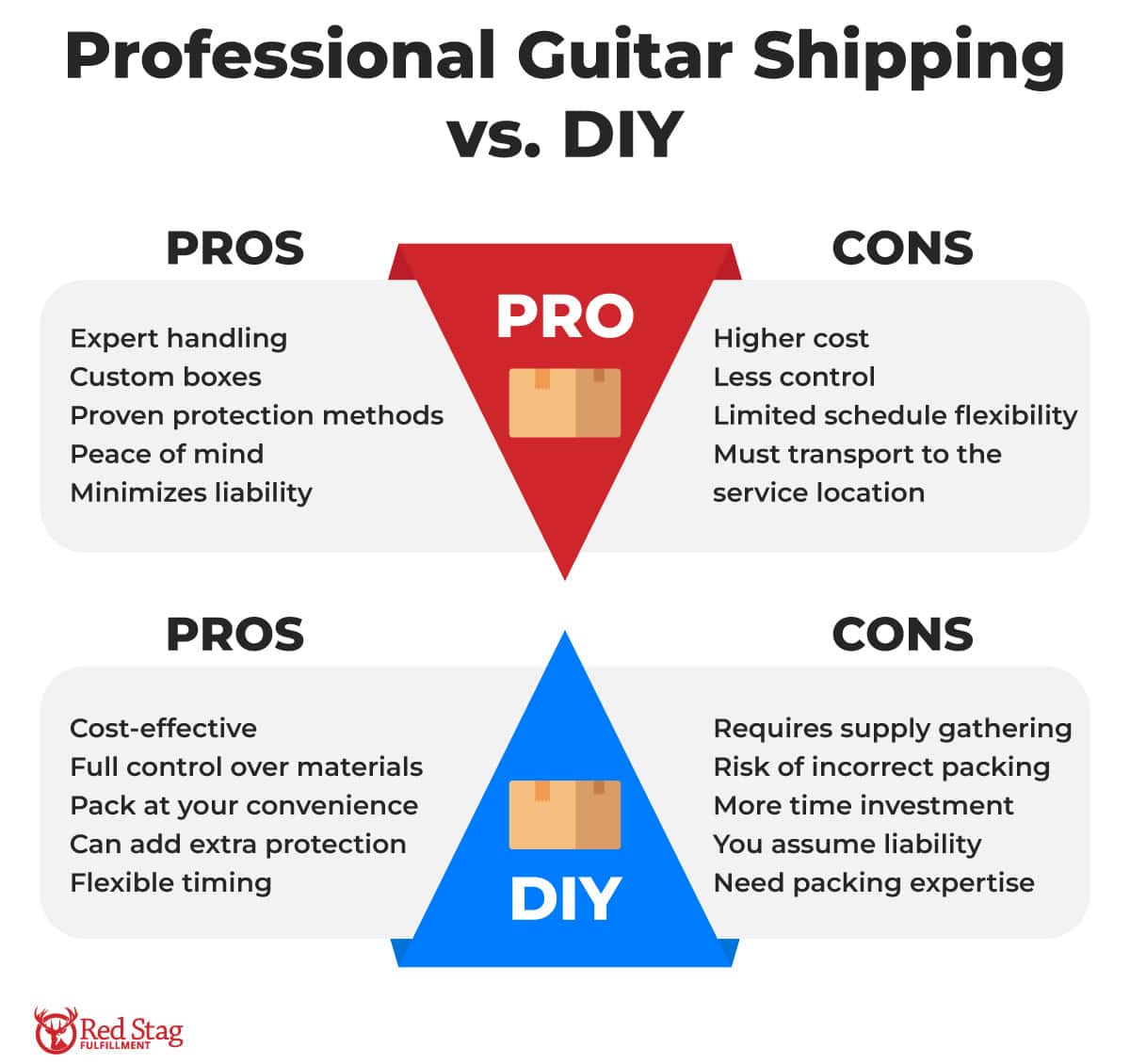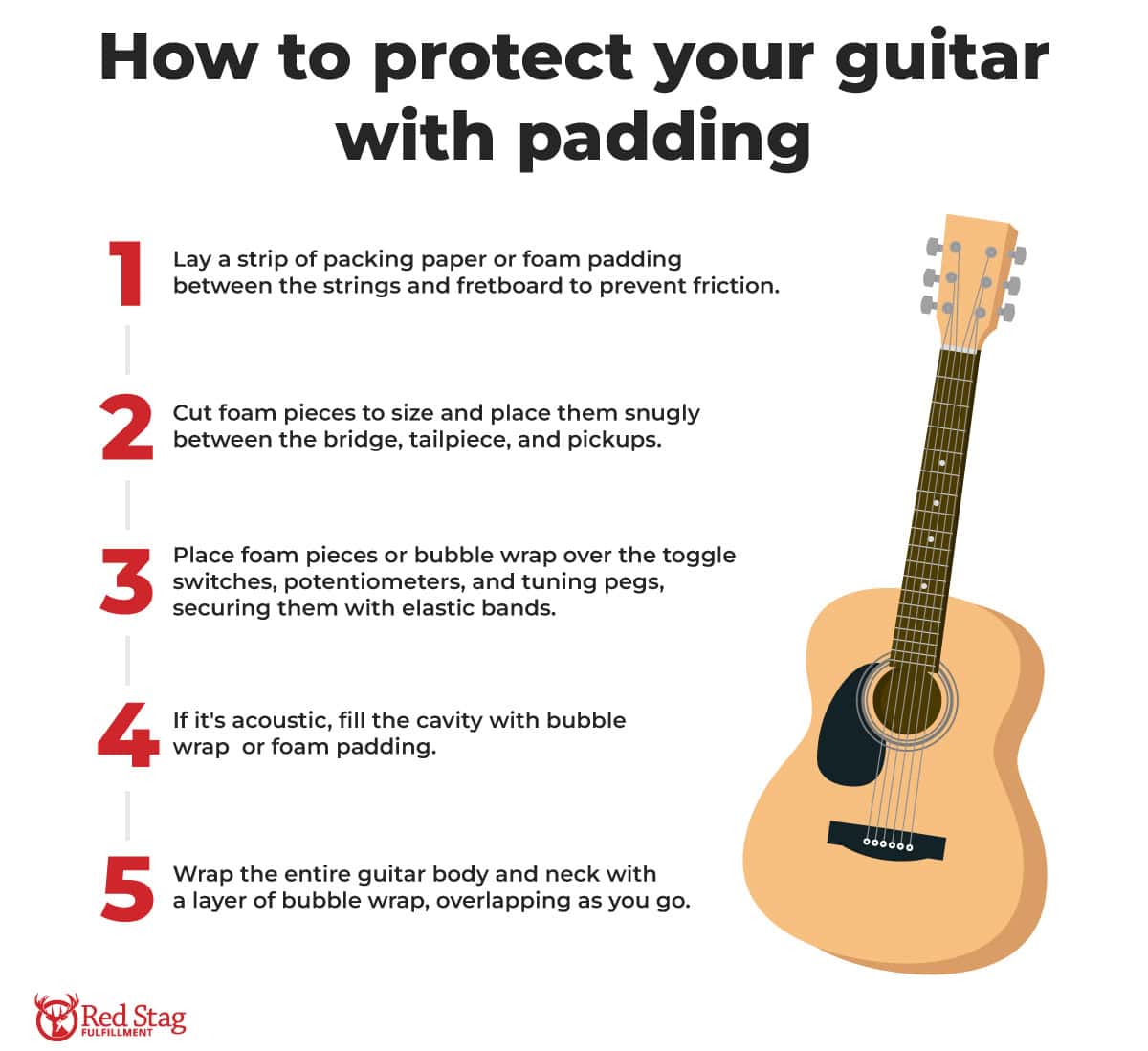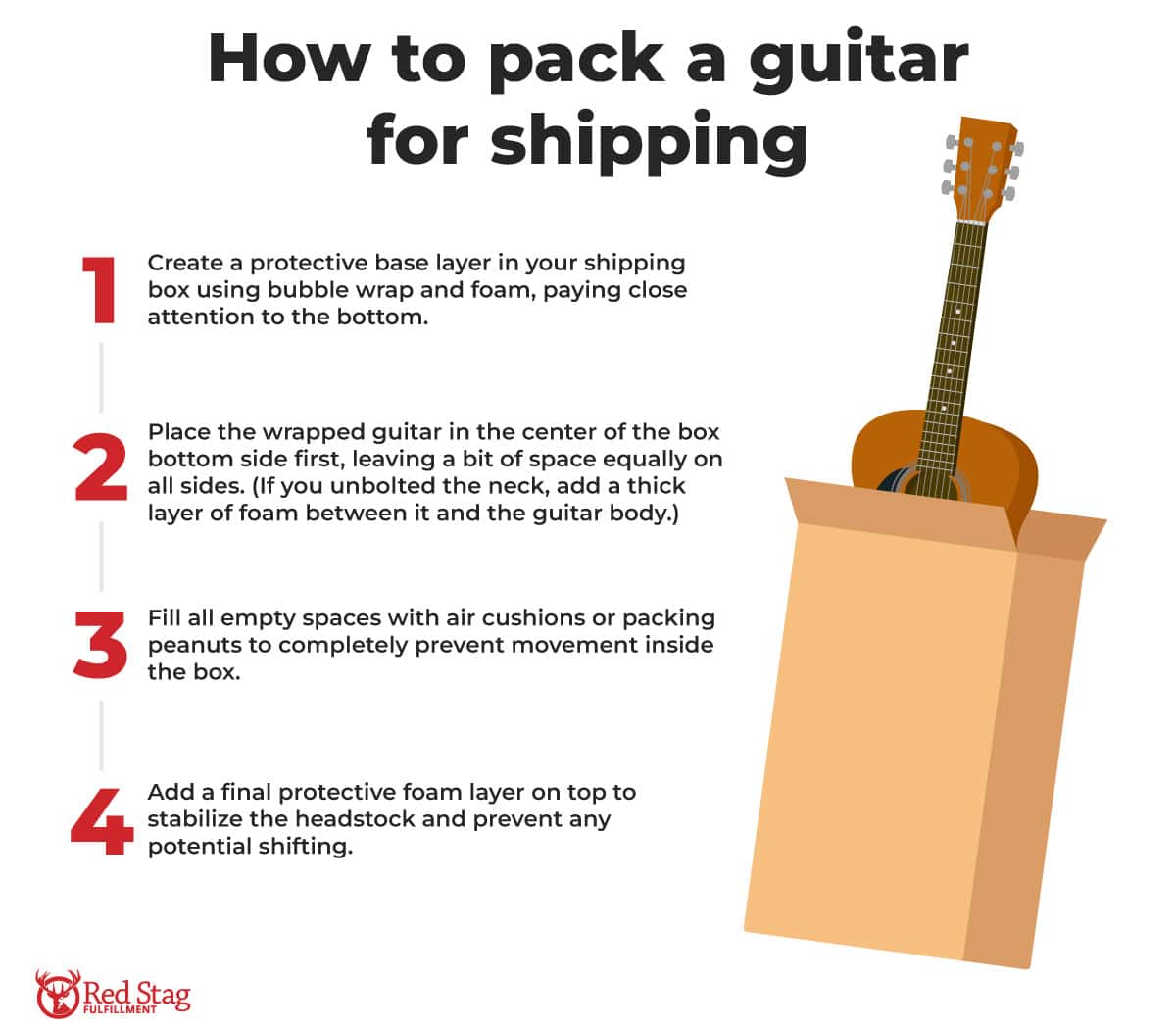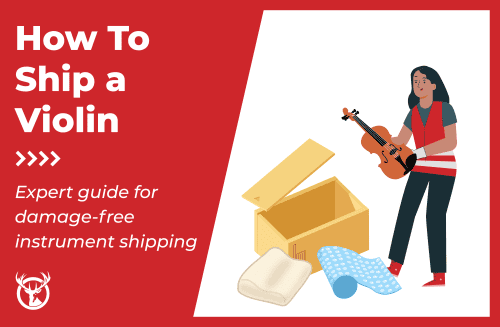Shipping a guitar requires more than just putting it in a box and hoping for the best. One wrong move can turn your cherished instrument or valuable inventory into a costly disaster.
As experts in shipping fragile, high-value items, we know that proper packaging and shipping methods make all the difference between safe delivery and devastating damage. Whether you’re selling your prized Stratocaster or sending an acoustic for repairs, this comprehensive guide will show you exactly how to package and ship your guitar safely and affordably.

TL;DR:
Key takeaways

Costs: Ground shipping costs $32–$98 across the U.S., while express shipping runs $158–$525. Save money by using business addresses for pickup/delivery. Insurance is recommended for valuable guitars.

Preparation: Loosen or remove strings to prevent neck warping. Remove any detachable parts (whammy bars, knobs, strap buttons). Take detailed photos of the guitar’s condition before shipping.

Packaging: Start with a hardshell case and add a sturdy box with extra space for padding. Reinforce protection at the headstock and neck joints. Pack with bubble wrap and foam until the guitar doesn’t move when shaken.

Shipping tips: Apply “Fragile” and “This Way Up” labels clearly on all sides. Have the recipient inspect the guitar before signing for delivery. Document any damage immediately with photos for claims. Consider a 3PL service for high-volume shipping needs.

PRO TIP: If you sell guitars or other large products, partnering with a 3PL that specializes in big, heavy, and bulky fulfillment—like Red Stag Fulfillment—can save you money (especially on shipping surcharges for large items) and let you focus on what really moves the needle in your business.
To learn more about how we can handle the heavy lifting of your fulfillment operations, reach out today.
A step-by-step guide to shipping your guitar
Proper preparation and packaging protect your guitar from damage during shipping. Follow these essential steps so your guitar arrives safely at its destination.
Clean and prepare your guitar
01
Remove all dirt and residue from your guitar using a microfiber cloth and gentle cleaning solution.
Pay special attention to the strings and fretboard. After cleaning, apply some fretboard conditioner to prevent the wood from drying out or cracking during transit.
Reduce string tension
Loosen or completely remove your guitar strings before shipping. Keeping strings at full tension can warp the neck during transport, especially on bass guitars, which have thicker strings and longer necks. Loosening the strings also prevents them from breaking during shipping.
Remove detachable parts
Take off any parts that could become damaged or lost during shipping.
Store these components in a sealed plastic bag:

Whammy bar

Volume and tone knobs

Switch caps

Guitar strap and strap buttons

Locking nut clamps and screws (for guitars with a Floyd Rose-style bridge)
Use this opportunity to inspect your guitar for any loose components and tighten them before shipping, such as the input jack and potentiometers.
For guitars with bolt-on necks, consider removing the neck entirely. This extra step significantly reduces the risk of neck damage during transit.
Next, loosen the strings to reduce tension or remove them altogether. This step is crucial, as leaving the neck under tension during shipping can warp the wood, especially on bass guitars, due to their thicker strings and longer necks. It also means your strings won’t snap.

PRO TIP: If your guitar has a bolt-on neck, consider removing it. This minimizes the chances of the neck snapping in transit.
Document your guitar’s condition
Take detailed photos of your guitar before shipping, including close-ups of any existing wear or damage. These photos provide essential documentation if you need to file a shipping insurance claim.
Focus on capturing clear images of:

Front and back of the body

Both sides of the neck

Headstock

Any cosmetic flaws or damage

Serial number
Choose your packaging method
02
When it comes to packaging your guitar for shipment, you have two main options: professional services or DIY packaging. Your choice affects both cost and control over the protection of your instrument.

Professional packaging services
Major carriers like UPS and FedEx offer specialized guitar shipping services that take the guesswork out of packaging.
Their trained staff use custom shipping boxes and professional-grade materials specifically designed for musical instruments. You simply bring your guitar to a UPS store, FedEx office, or another shipping location, and their staff will handle the entire packing process to ensure maximum protection.

While professional packaging costs more than DIY, the service provides peace of mind through expert handling and proven protection methods.
DIY Packaging
Packaging your guitar yourself gives you complete control over the process while reducing costs. You can add more layers of protection where needed, using enough packing material to make the guitar super secure.
Get a guitar shipping box and packaging materials
03
A hardshell case and proper packaging materials are essential for shipping your guitar safely. While a gig bag offers some padding, it can’t provide adequate protection during transit.
Before packing your guitar, gather these essential supplies:

Tape measure

Utility knife

Corrugated guitar box that fits your guitar

Bubble wrap

Packing foam

Air cushions or packing peanuts

Packing and clear tape

Elastic bands

(Optional) packing paper
Selecting the right box size is crucial for guitar shipping. Even with a hardshell case, choose a sturdy cardboard box large enough to allow for cushioning. Measure your guitar case and select a box with several inches of space on all sides for packing materials.
Local guitar stores may offer suitable boxes for free or a small fee. Avoid using old or damaged boxes, as they compromise protection. You can double-box your guitar for extra protection, but a corrugated box already provides two layers of protection.
For new boxes in specific sizes, suppliers like Uline offer a wide range of shipping boxes.

PRO TIP: Always measure both your guitar and case dimensions carefully before ordering or selecting a box.
Protect your guitar with padding
04
Proper padding protects your guitar during transit.

Follow these steps to do it correctly:
01
Lay a strip of packing paper or foam padding between the strings and fretboard to prevent friction.
02
Cut foam pieces to size and place them snugly between the bridge, tailpiece, and pickups.
03
Place foam pieces or bubble wrap over the toggle switches, potentiometers, and tuning pegs, securing them with elastic bands.
04
If it’s acoustic, fill the cavity with bubble wrap or foam padding.
05
Wrap the entire guitar body and neck with a layer of bubble wrap, overlapping as you go.
Focus extra attention on two critical vulnerable points: where the headstock meets the neck and where the neck joins the body.
These areas demand additional bubble wrap layers secured firmly with elastic bands to prevent breakage.

PRO TIP: If you’re shipping multiple guitars, consider consolidating the package into a single box to save on costs.
Pack and secure your guitar in the box
05

With your guitar ready, it’s now time to prepare the box for shipping:
01
Create a protective base layer in your shipping box using bubble wrap and foam, paying close attention to the bottom.
02
Place the wrapped guitar in the center of the box bottom side first, leaving a bit of space equally on all sides. (If you unbolted the neck, add a thick layer of foam between it and the guitar body.)
03
Fill all empty spaces with air cushions or packing peanuts to completely prevent movement inside the box.
04
Add a final protective foam layer on top to stabilize the headstock and prevent any potential shifting.

PRO TIP: After packing, gently shake the box. If packed correctly, you won’t hear any movement inside the box.
Seal and label the package
06
First, seal the box securely with strong packing tape, ensuring all edges and seams are covered. For used boxes, remove or cover any old shipping labels and barcodes to prevent routing errors.
After sealing, it’s time to label the package:

Print and apply “Fragile,” “Handle with Care,” and “This Way Up” labels on opposite sides of the box.

Attach the shipping label in a prominent spot, ensuring it includes complete addresses and contact details.

For international shipments, attach any required customs documentation.

ALERT: Place shipping labels on a flat area and cover them entirely with clear tape to protect against water.
Select your shipping carrier and service level
07
Your guitar is now ready for shipping, so it’s time to select your shipping method. Traditional carrier shipping is often the most cost-effective and offers reliable safety.

PRO TIP: If you’re shipping multiple guitars or other heavy equipment, consider using LTL shipping instead.
The final shipping cost depends on the following:

Weight

Package size

Distance

Shipping speed

Insurance
While guitars aren’t typically heavy, they can still trigger an oversize charge if the shipping box exceeds specific size limits. Carriers calculate shipping costs based on dimensional weight, which factors in the size of the package rather than just its physical weight.
Real-world example
Let’s use a real example of what it costs to ship an 8-pound (3.63 kg) Stratocaster-style guitar in an 18″ x 6″ x 45″ (45.72 x 15.24 x 114.3 cm) box.
| from | new york to atlantic city |
new york to chicago |
new york to los angeles |
|||
|---|---|---|---|---|---|---|
| shipping method |
cost to ship ~130 miles ($) |
days in transit |
cost to ship ~800 miles ($) |
days in transit |
cost to ship ~2450 miles ($) |
days in transit |
| UPS Ground ($) | 32.00 | 1 | 55.94 | 3 | 98.32 | 5 |
| UPS Next Day Air® Early | 158.39 | 1 | 395.82 | 1 | 449.41 | 1 |
| FedEx Ground | 32.58 | 1 | 59.90 | 2 | 105.64 | 6 |
| FedEx First Overnight® | 198.37 | 1 | 465.43 | 1 | 525.91 | 1 |
| USPS Ground Advantage | 64.75 | 3 | 90.35 | 4 | 127.40 | 7 |
| USPS Priority Mail® | 176.40 | 1 | 288.10 | 1 | 316.10 | 1 |
Use the following carrier calculators to check shipping rates for your guitar:
Minimal shipping costs
| shipping method | cost to ship ~130 miles | cost to ship ~800 miles | cost to ship ~2450 miles |
|---|---|---|---|
| UPS Ground | $32.00 | $55.94 | $98.32 |
| FedEx Ground | $32.58 | $59.90 | $105.64 |
| USPS Ground Advantage | $64.75 | $90.35 | $127.40 |
Priority shipping costs
| shipping method | cost to ship ~130 miles | cost to ship ~800 miles | cost to ship ~2450 miles |
|---|---|---|---|
| UPS Next Day Air® Early | $158.39 | $395.82 | $449.41 |
| FedEx First Overnight® | $198.37 | $465.43 | $525.91 |
| USPS Priority Mail® | $176.40 | $288.10 | $316.10 |

PRO TIP: Compare carrier rates to find the best option, as prices can vary widely for the same service level.
Insurance is strongly recommended
When shipping high-value guitars, insurance isn’t just a recommendation—it’s a necessity to safeguard your investment from potential damage or loss.
Although standard carrier coverage offers basic protection, it’s often insufficient for valuable stringed instruments. Purchasing additional insurance protects your guitar for its full value, providing peace of mind.
For vintage or collectible guitars, obtain a professional assessment of their condition and value.
Schedule pickup or drop-off
08
Once your guitar is packed, you’ll need to choose between pickup or drop-off service.
- Pickup service.
Most carriers offer pickup at your location, which is ideal for larger guitars or tight schedules. It’s convenient but more expensive than drop-off. - Drop-off.
Delivering your guitar to a local facility can save you money, though it requires more effort.
Check your carrier’s nearest drop-off location and their hours before deciding.

PRO TIP: You can save on shipping costs by using a business address for pickup and drop-off.
Provide tracking information and delivery instructions
09
Proper inspection at delivery protects both parties against any potential shipping damage. After providing a tracking number, instruct the recipient to follow these steps when their guitar arrives:
Inspection and assessment
The recipient should open the package and inspect the guitar while the delivery person waits. This gives them the opportunity to address any visible damage before accepting the package.
They should carefully examine:
- Body.
Check for dents, scratches, or cracks, especially along the edges and back. - Neck and headstock.
Inspect closely to look for signs of cracks along the whole length of the neck, paying particular attention to the headstock area. - Frets and fingerboard.
Inspect for any loose or damaged frets and make sure the fingerboard is intact without cracks or gouges. - Strings and hardware.
Verify that the strings are intact, the tuning pegs are undamaged, and the hardware is secure. - Accessories.
Confirm all accessories are present and undamaged.
Signing requirements
Instruct the recipient not to sign the delivery receipt until they’ve completed a thorough inspection. Signing the receipt confirms they’ve accepted the guitar in acceptable condition, which may complicate the process of filing a claim if damage is discovered later.
Handling damage
If the recipient discovers any damage, they should take the following steps:

Document the damage with clear, detailed photographs focusing on the affected areas.

Refuse the delivery if damage is noticed.

Contact the sender and shipping company immediately to report the issue and start the claims process.
Scale your guitar shipping with a trusted 3PL for smooth delivery
Are you running an ecommerce business selling guitars? At Red Stag Fulfillment, we specialize in shipping delicate, high-value items like guitars with care and precision.
Our nationwide fulfillment network ensures your guitars reach 96% of U.S. addresses within two days.
Here’s how we make shipping hassle-free for you:

Efficient warehousing and inventory management

Secure, professional packing to prevent damage

Exclusive carrier discounts to save you money

Guaranteed on-time delivery, or we make it right
We’re so confident in our ability to deliver your guitars safely and on time we’ll even pay for our mistakes. Focus on scaling your business, not packing boxes. Contact Red Stag Fulfillment today to learn more about how we can handle your guitar shipping needs.










